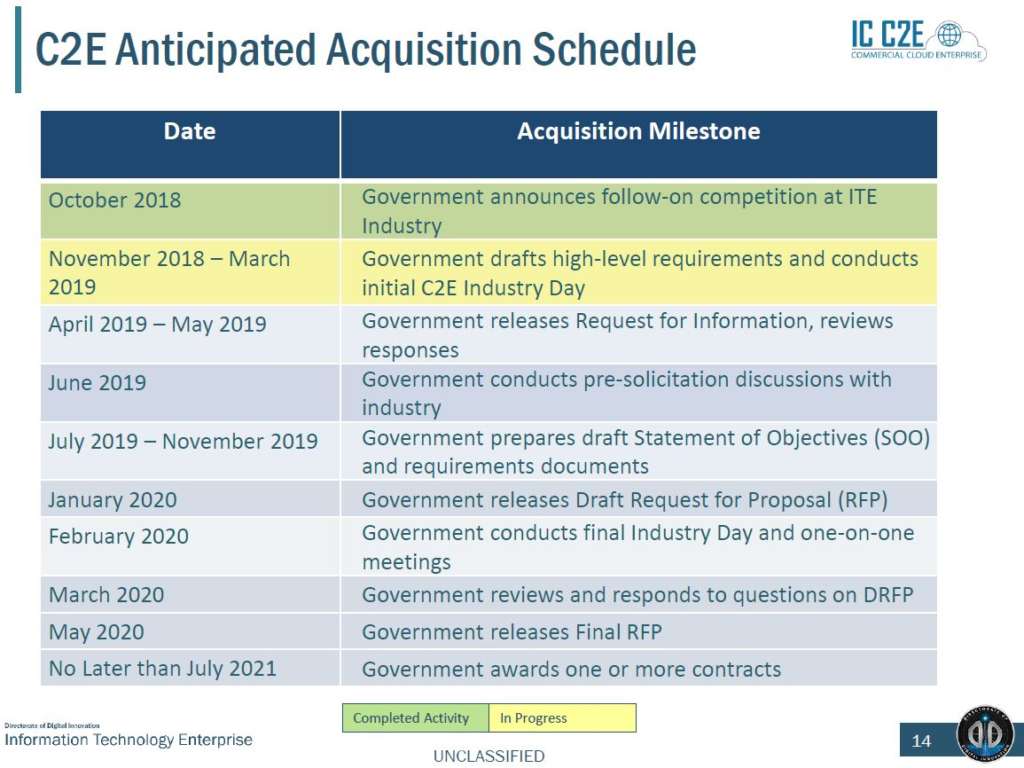
Is the CIA’s new cloud procurement a signal to DoD to update JEDI?
Industry experts say the CIA’s C2E cloud procurement demonstrates that a multi-cloud, multi-vendor approach is necessary for the agency’s needs of today and...
Best listening experience is on Chrome, Firefox or Safari. Subscribe to Federal Drive’s daily audio interviews on Apple Podcasts or PodcastOne.
The CIA created quite a stir in the federal IT community as word spread over the last week that it’s ready to upgrade its commercial cloud offering called Commercial Cloud Services (C2S).
As the industry day documents spread like wildfire across industry and the media, the question we have to ask is the CIA, the intelligence community more generally, trying to give the Defense Department some top cover for its controversial and protest entangled Joint Enterprise Defense Initiative (JEDI) cloud procurement?
When you review the CIA’s market research survey as well as its industry day presentation, everything about it seems to be saying “Hey DoD, we have seen the light and multi-cloud, multi-vendor is the only way to go.”
The intel agency said in its market research survey that it “will acquire foundational cloud services, as defined in the scope section below, from multiple vendors.”
In industry day documents, the CIA said that the Commercial Cloud Enterprise’s (C2E) program objective is to “acquire cloud computing services directly from commercial cloud service providers…”
The CIA said it plans to award one or more indefinite delivery, indefinite quantity type contracts.
Industry experts said the message couldn’t be any clearer to DoD and it’s plans for JEDI.

“C2E puts the conversation on a different trajectory. It puts out there that the IC has identified new needs so the prudent person would go back and ask the question, ‘if they need hybrid, on premise and commercial cloud, does that change the thinking at DoD?’” said Trey Hodgkins, president and CEO of Hodgkins Consulting. “I don’t think there is any visibility into DoD’s thought process, but you’d have to think they are asking the same question at the department.”
DoD currently is conducting an internal review of JEDI after a bid protest from Oracle highlighted a potential conflict of interest. Additionally, DoD and JEDI are facing a potential FBI investigation.
Sam Gordy, the general manager of IBM federal, said the CIA strategy with C2E should not only inform DoD, but influence the Pentagon’s plans going forward.
“These [C2E and JEDI] are diametrically opposed approaches. Clearly the CIA has five-to-six years of experience in a single cloud environment and they are making a strategic decision to wholeheartedly move into multi cloud world. It’s a critical next step for the evolution of IT support for the IC,” Gordy said in an interview with Federal News Network. “DoD should take advantage of those five-to-six years of experience in the IC and the national security community to inform what they are doing going forward.”
Gordy said the CIA is taking the approach that the private sector has moved to over the last few years. He added that unlike JEDI, the CIA is making it clear why the multi-cloud approach is necessary because they are saying in the industry day documents and the market survey what they want to use the cloud for today and in the future.
Under phase 1, the CIA said it wants vendors to provide infrastructure-, platform- and software-as-a-service capabilities as well as support services.

“Knowing they have an enterprisewide cloud contract already and that they are using that capability, this tells me they need hybrid, on-premise and commercial solution and this creates a mechanism to do that,” Hodgkin said. “I didn’t see anything shocking or that caught me off guard. The CIA has clearly spelled out to the industrial base what they need, and one of them is to deliver some or all of the three types of cloud, and when they put their data into those clouds, it must be portable so they can move it to another cloud or somewhere else. Those are the two elements that are different than what they have now, and ones that you haven’t seen it called out in previous acquisitions, at least not at this level.”
CIA needs cloud diversity, data portability
John Weiler, the executive director of the IT Acquisition Advisory Council and an outspoken critic of JEDI, said the CIA’s approach for C2E is a recognition that the current C2S contract isn’t working like they expected.
“If it had worked they would’ve just resigned up with Amazon Web Services,” Weiler said. “One cloud can’t solve all your problems. When you look at workloads on Oracle or legacy Microsoft platforms, it makes no sense to move them to Amazon or Google or IBM. Those cloud are not designed for those environments. These strategies to be effective have to acknowledge that there are certain platforms that are legacy can move to a specific cloud and not just to any cloud.”
Related Stories

FBI, DoD IG conducting preliminary investigation into JEDI, procurements

10 BILLION DOLLARS and other reasons why contractors feel so much angst around DoD’s JEDI program
Thirst for new technologies, new capabilities driving IC’s cloud expansion
One industry source, who requested anonymity in order to talk about inner working of the IC, said there have been varying degrees of unhappiness with the Amazon contract, including at least two IC agencies rejecting the C2S cloud and building their own.
Another industry source said in many ways C2S was a long-term pilot and now the CIA and others in the IC recognize they weren’t happy with the price they were getting for cloud services, interoperability was more difficult than first imagined especially between C2S and existing data centers, and they were limited in the ability to add new features in a timely manner.
“They’ve had time to see what works and what doesn’t, and they’ve realized cloud providers are becoming specialized. It’s easier to move workloads from on-premise to the cloud with the same vendor. They realized migrations can be expensive,” the source said. “The CIA realized that cloud diversity and price competition help bring down costs. The industry and the CIA weren’t in a position to do that six years ago, but now they are, which is good.”
The first industry source added the IC had real concerns about vendor lock-in and how hard it was to move data between cloud infrastructures.
“I’ve heard that a lot that people didn’t expect going into Amazon to have the level of lock-in that they have. Once they migrated data to Amazon, it became much more difficult to lift and shift to say a Microsoft cloud because the systems was configured in way that was only good for the Amazon cloud,” the source said.
Implementation of cloud services is key
A third industry source was even more blunt about the C2S contract:
“AWS has relentlessly leveraged C2S since its inception, proclaiming to federal agencies that there was only one cloud service provider good enough for the CIA, so they needn’t look further. But like a handsy, insecure boyfriend, it seems like AWS held the CIA a little too close, proudly boasting about their exclusive relationship while competing suitors flexed their innovation muscles,” source said. “Not surprisingly, since the relationship first began, the CIA has noticed it has options and doesn’t need to commit. So while it’s understandable AWS wants to put a ring on it, the agency would clearly rather stay friends and play the field.”
An AWS spokesman said they are excited about C2E and the CIA’s intent to build on the existing C2S efforts.
“As a customer obsessed organization, we’re focused on driving innovation that supports the mission and spurs solutions that allow for missions to be performed better, faster, and in a more secure manner,” the spokesman said.
Weiler said no matter the strategy that the CIA or DoD chooses, the key is the implementation. He said nearly every agency needs to address legacy systems and the consistent challenge of cloud migration.
IBM’s Gordy said C2S shouldn’t be considered a failure by any means as it greatly helped inform the CIA’s current strategy.
“This does sync up with a recompete on C2S, but I don’t think C2E is in anyway a replacement for C2S,” he said. “The CIA will probably continue to have the need for a broad business application cloud which is what C2S is being used for today. And then they will need to have a mission oriented cloud, which is the reason they are going to C2E, which seems to be for the optimization of those mission workloads.”
Copyright © 2024 Federal News Network. All rights reserved. This website is not intended for users located within the European Economic Area.
Jason Miller is executive editor of Federal News Network and directs news coverage on the people, policy and programs of the federal government.
Follow @jmillerWFED



